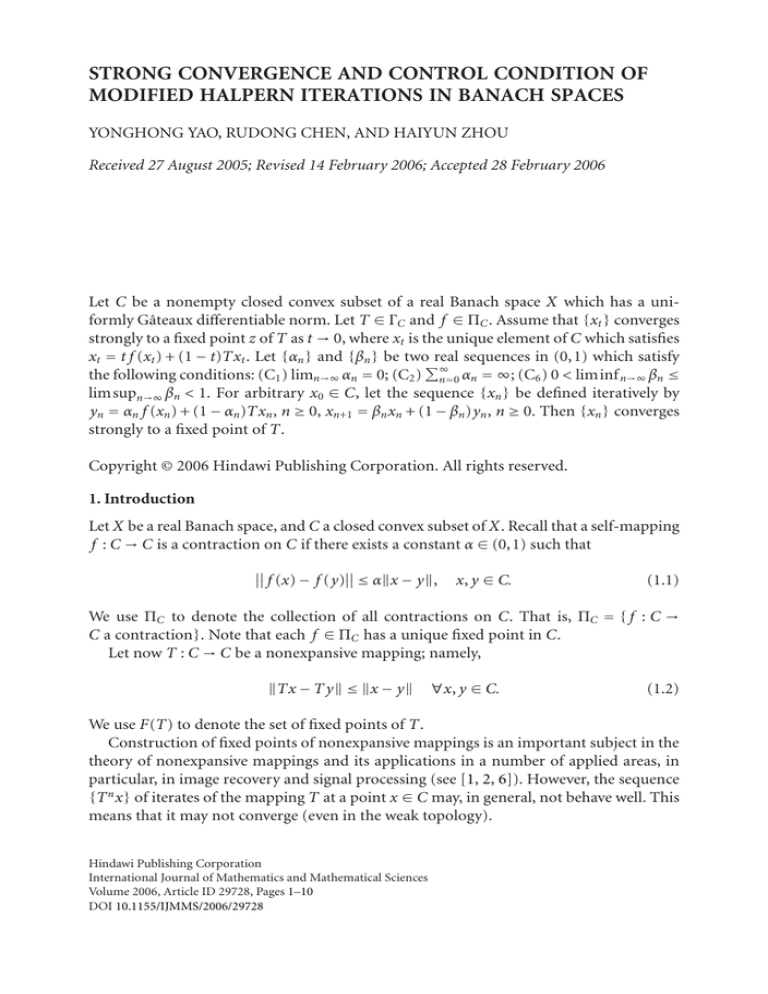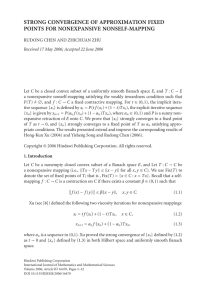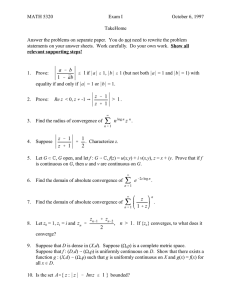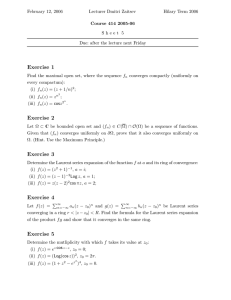
STRONG CONVERGENCE AND CONTROL CONDITION OF
MODIFIED HALPERN ITERATIONS IN BANACH SPACES
YONGHONG YAO, RUDONG CHEN, AND HAIYUN ZHOU
Received 27 August 2005; Revised 14 February 2006; Accepted 28 February 2006
Let C be a nonempty closed convex subset of a real Banach space X which has a uniformly Gâteaux differentiable norm. Let T ∈ ΓC and f ∈ ΠC . Assume that {xt } converges
strongly to a fixed point z of T as t → 0, where xt is the unique element of C which satisfies
xt = t f (xt ) + (1 − t)Txt . Let {αn } and {βn } be tworeal sequences in (0,1) which satisfy
the following conditions: (C1 ) limn→∞ αn = 0; (C2 ) ∞
n=0 αn = ∞; (C6 ) 0 < liminf n→∞ βn ≤
limsupn→∞ βn < 1. For arbitrary x0 ∈ C, let the sequence {xn } be defined iteratively by
yn = αn f (xn ) + (1 − αn )Txn , n ≥ 0, xn+1 = βn xn + (1 − βn )yn , n ≥ 0. Then {xn } converges
strongly to a fixed point of T.
Copyright © 2006 Hindawi Publishing Corporation. All rights reserved.
1. Introduction
Let X be a real Banach space, and C a closed convex subset of X. Recall that a self-mapping
f : C → C is a contraction on C if there exists a constant α ∈ (0,1) such that
f (x) − f (y) ≤ αx − y ,
x, y ∈ C.
(1.1)
We use ΠC to denote the collection of all contractions on C. That is, ΠC = { f : C →
C a contraction}. Note that each f ∈ ΠC has a unique fixed point in C.
Let now T : C → C be a nonexpansive mapping; namely,
Tx − T y ≤ x − y ∀x, y ∈ C.
(1.2)
We use F(T) to denote the set of fixed points of T.
Construction of fixed points of nonexpansive mappings is an important subject in the
theory of nonexpansive mappings and its applications in a number of applied areas, in
particular, in image recovery and signal processing (see [1, 2, 6]). However, the sequence
{T n x} of iterates of the mapping T at a point x ∈ C may, in general, not behave well. This
means that it may not converge (even in the weak topology).
Hindawi Publishing Corporation
International Journal of Mathematics and Mathematical Sciences
Volume 2006, Article ID 29728, Pages 1–10
DOI 10.1155/IJMMS/2006/29728
2
Strong convergence and control condition
One way to overcome this difficulty is to use Mann’s iteration method that produces a
sequence {xn } via the recursive manner:
xn+1 = αn xn + 1 − αn Txn ,
n ≥ 0,
(1.3)
where the initial guess x0 ∈ C is chosen arbitrarily. For example, Reich [7] proved that if
X is a uniformly convex Banach space with a Frechet differentiable norm and if {αn } is
chosen such that ∞
n=1 αn (1 − αn ) = ∞, then the sequence {xn } defined by (1.3) converges
weakly to a fixed point of T. However, this scheme has only weak convergence even in a
Hilbert space [3].
Some attempts to construct iteration method so that strong convergence is guaranteed
have recently been made.
For a sequence {αn } of real numbers in [0,1] and an arbitrary u ∈ C, let the sequence
{xn } in C be iteratively defined by x0 ∈ C,
xn+1 = αn u + 1 − αn Txn .
(1.4)
The iterative method (1.4) is now referred to as the Halpern iterative method in the
light of [4]. He proved the weak convergence of {xn } to a fixed point of T where αn = n−a ,
a ∈ (0,1).
In 1977, Lions [5] improved the result of Halpern, by proving strong convergence of
{xn } to a fixed point of T where the real sequence {αn } satisfies the following conditions:
limn→∞ αn = 0;
(C1 ) (C2 ) ∞
n=0 αn = ∞;
(C3 ) limn→∞ (αn − αn−1 )/α2n = 0.
It was observed that Lions’ conditions on the real sequence {αn } excluded the canonical choice αn = 1/(n + 1). This was overcome in 1992 by Wittmann [10]. He proved the
following theorem.
Theorem 1.1. Let H be a Hilbert space, let C be a nonempty closed and convex subset of H
and T ∈ΓC . Let {αn } be a sequence in [0,1] fulfilling (C1 ), (C2 ), and
(C4 ) ∞
n=0 |αn+1 − αn | < ∞.
For arbitrary initial value x0 = u ∈ C, define iteratively the sequence {xn } as in (1.4). Then
the sequence {xn } converges strongly to the element of F(T) which is nearest to u.
At this point, we have to remark that the result of Wittmann is basic and important.
Reich [8] extended the Wittmann’s result to uniformly smooth Banach spaces which have
weakly sequentially continuous duality maps. In 2002, Xu [11] improved Lions’ result as
follows.
Theorem 1.2. Let X be a uniformly smooth real Banach space, let C be a closed convex
subset of X, and T ∈ ΓC . Let u,x0 ∈ C be given. Assume that {αn } ⊂ [0,1] satisfies the conditions (C1 ), (C2 ) and,
(C5 ) limn→∞ (αn − αn−1 )/αn = 0.
Then the sequence {xn } defined by (1.4) converges strongly to a fixed point of T.
Yonghong Yao et al. 3
He showed that condition (C3 ) of Lions and condition (C5 ) are not comparable. Xu
also remarked that Halpern observed that conditions (C1 ) and (C2 ) are necessary for the
strong convergence of algorithm (1.4) for all nonexpansive mappings.
Remark 1.3. We note that Theorem 1.2 weakened the condition (C3 ) by removing the
square in the denominator so that the canonical choice of αn = 1/(n + 1) is possible. On
the other hand, Xu proved the strong convergence of the scheme in the framework of real
uniformly smooth Banach spaces.
It is our purpose in this paper to propose a modification of Halpern’s iteration method
inspired by the ideas in [11]. Our modified Halpern’s iteration scheme is defined as follows.
Let C be a closed convex subset of a Banach space and T ∈ ΓC and f ∈ ΠC . Define {xn }
in the following way:
yn = αn f xn + 1 − αn Txn ,
xn+1 = βn xn + 1 − βn yn ,
n ≥ 0,
(1.5)
n ≥ 0,
where {αn } and {βn } are two sequences in (0,1). We prove, under certain appropriate
assumptions on the sequences {αn } and {βn }, that {xn } converges to a fixed point of T.
2. Preliminaries and lemmas
Let X be a real Banach space. Recall that the (normalized) duality map from X into X ∗ ,
the dual space of X, is given by
2 J(x) = x∗ ∈ X ∗ : x,x∗ = x2 = x∗ ,
x ∈ X.
(2.1)
Let S = {x ∈ X : x = 1} denote the unit sphere of X. X is said to have a Gâteaux differentiable norm if the limit
lim
x + t y − x t
t →0
(2.2)
exists for each x, y ∈ X, and X is said to have a uniformly Gâteaux differentiable norm if
for each y ∈ S, the limit is attained uniformly for x ∈ S. Let X be a normed space with
dimX ≥ 2. The modulus of smoothness of X is the function ρX : [0, ∞) → [0, ∞) defined
by
ρX (τ) = sup
x + y + x − y 2
− 1 : x = 1, y = τ .
(2.3)
The space X is called uniformly smooth if and only if limt→0+ ρX (t)/t = 0.
Now, we introduce several lemmas for our main results in this paper.
The first lemma is a very well-known (subdifferential) inequality.
Lemma 2.1. Let X be a real Banach space and J the normalized duality map on X. Then for
any given x, y ∈ X, the following inequality holds:
x + y 2 ≤ x2 + 2 y, j(x + y) ,
∀ j(x + y) ∈ J(x + y).
(2.4)
4
Strong convergence and control condition
Lemma 2.2 [9]. Let {xn } and { yn } be bounded sequences in a Banach space X and let {βn }
be a sequence in [0,1] which satisfies the following condition:
(C6 ) 0 < liminf n→∞ βn ≤ limsupn→∞ βn < 1.
Suppose
xn+1 = βn xn + 1 − βn yn ,
n ≥ 0,
limsup yn+1 − yn − xn+1 − xn ≤ 0.
(2.5)
n→∞
Then limn→∞ yn − xn = 0.
Lemma 2.3 [12]. Assume {an } is a sequence of nonnegative real numbers such that
an+1 ≤ 1 − γn an + δn ,
n ≥ 0,
(2.6)
γn } is a sequence in (0,1) and {δn } is a sequence in R such that
where {
(C7 ) ∞
n =0 γ n = ∞ ;
(C8 ) limsupn→∞ δn /γn ≤ 0 or ∞
n=0 |δn | < ∞.
Then limn→∞ an = 0.
Lemma 2.4 [13]. Let X be a uniformly smooth Banach space, C a closed convex subset of X.
T : C → C a nonexpansive mapping with F(T) = ∅, and f ∈ ΠC . Then {xt } defined by
xt = t f xt + (1 − t)Txt
(2.7)
converges strongly to a point in F(T).
3. Main results
Theorem 3.1. Let C be a nonempty closed convex subset of a real Banach space X which
has a uniformly Gâteaux differentiable norm. Let T ∈ ΓC and f ∈ ΠC . Assume that {xt }
converges strongly to a fixed point z of T as t → 0, where xt is the unique element of C which
satisfies xt = t f (xt ) + (1 − t)Txt . Let {αn } and {βn } be two real sequences in (0,1) which
satisfy the conditions (C1 ), (C2 ), and (C6 ).
For arbitrary x0 ∈ C, define iteratively the sequence {xn } as in (1.5). Then the sequence
{xn } converges strongly to a fixed point of T.
Proof. First, we observe that {xn } is bounded.
Indeed, if we take a fixed point p of T, note that
xn+1 − p ≤ βn xn − p + 1 − βn yn − p
≤ βn + 1 − βn 1 − αn xn − p + 1 − βn αn f xn − f (p)
+ 1 − βn αn f (p) − p
≤ 1 − (1 − α)αn + (1 − α)αn βn xn − p + 1 − βn αn f (p) − p
f (p) − p
.
≤ max xn − p,
1−α
(3.1)
Yonghong Yao et al. 5
Now, an induction yields
xn − p ≤ max x0 − p, f (p) − p .
1−α
(3.2)
Hence, {xn } is bounded, so are {Txn }, { yn }, and { f (xn )}.
Observe that
yn+1 − yn = αn+1 f xn+1 + 1 − αn+1 Txn+1 − αn f xn − 1 − αn Txn
= αn+1 − αn f xn+1 + αn f xn+1 − f xn
+ 1 − αn+1 Txn+1 − Txn + αn − αn+1 Txn .
(3.3)
It follows from (3.3) that
yn+1 − yn − xn+1 − xn ≤ αn+1 − αn f xn+1 + Txn + αn f xn+1 − f xn .
(3.4)
Since { f (xn )}, {Txn } are bounded, we obtain that
limsup yn+1 − yn − xn+1 − xn ≤ 0.
(3.5)
n→∞
Hence, by Lemma 2.2, we have
lim yn − xn = 0.
(3.6)
n→∞
Observe also that
yn − xn = αn f xn − xn + 1 − αn Txn − xn .
(3.7)
It follows from (C1 ), (3.6), and (3.7) that
lim xn − Txn = 0.
(3.8)
n→∞
We next show that
limsup f (z) − z, j xn − z
n→∞
≤ 0.
(3.9)
Let xt be the unique fixed point of the contraction mapping zt given by
zt x = t f (x) + (1 − t)Tx.
(3.10)
Then
xt − xn = t f xt − xn + (1 − t) Txt − xn .
(3.11)
6
Strong convergence and control condition
We apply Lemma 2.1 to get
xt − xn 2 ≤ (1 − t)2 Txt − xn 2 + 2t f xt − xn , j xt − xn
2
≤ (1 − t)2 Txt − Txn + Txn − xn 2
+ 2t f xt − xt , j xt − xn + 2t xt − xn 2
2
≤ (1 − t)2 xt − xn + an (t) + 2t xt − xn + 2t f xt − xt , j xt − xn ,
(3.12)
where
an (t) = Txn − xn 2xt − xn + Txn − xn −→ 0
as n −→ ∞.
(3.13)
The last inequality (3.12) implies
xt − f xt , j xt − xn
≤
t
xt − xn 2 + 1 an (t).
2
2t
(3.14)
It follows that
limsup xt − f xt , j xt − xn
n→∞
≤
t 2
M ,
2 1
(3.15)
where M1 > 0 is a constant such that M1 ≥ xt − xn for all t ∈ (0,1) and n ≥ 1.
Letting t → 0 in (3.15) and noting (3.13) yields
limsup limsup xt − f xt , j xt − xn
t →0
n→∞
≤ 0.
(3.16)
Moreover, we have that
z − f (z), j z − xn
= z − f (z), j z − xn − z − f (z), j xt − xn
+ z − f (z), j xt − xn − xt − f (z), j xt − xn
+ xt − f (z), j xt − xn − xt − f xt , j xt − xn
+ xt − f xt , j xt − xn
= z − f (z), j z − xn − j xt − xn
+ z − xt , j xt − xn + f xt − f (z), j xt − xn
+ xt − f xt , j xt − xn .
(3.17)
Yonghong Yao et al. 7
Then, we obtain
limsup z − f (z), j z − xn
n→∞
≤ sup z − f (z), j z − xn − j xt − xn + z − xt limsup xt − xn n→∞
n ∈N
+ f (xt ) − f (z) limsup xt − xn + limsup xt − f xt , j xt − xn
n→∞
≤ sup z − f (z), j z − xn − j xt − xn
n ∈N
n→∞
(3.18)
+ (1 + α)z − xt limsup xt − xn + limsup xt − f xt , j xt − xn .
n→∞
n→∞
By hypothesis that xt → z ∈ F(T) as t → 0 (see Lemma 2.4) and that j is norm-to-weak∗
uniformly continuous on bounded subset of C, we obtain
lim supz − f (z), j(z − xn ) − j(xt − xn ) = 0.
t →0 n∈N
(3.19)
Therefore, we have
limsup z − f (z), j z − xn
n→∞
= limsup limsup z − f (z), j z − xn
t →0
n→∞
t →0
n→∞
≤ limsup limsup xt − f xt , j xt − xn
(3.20)
≤ 0.
Finally, we show that xn → z as n → ∞.
Write
xn+1 − z = βn xn − z + 1 − βn yn − z
= βn xn − z + 1 − βn 1 − αn Txn − z + 1 − βn αn f xn − z ,
(3.21)
and apply Lemma 2.1 to get
xn+1 − z2 ≤ βn xn − z + 1 − βn 1 − αn Txn − z 2
+ 2 1 − βn αn f xn − z, j xn+1 − z
2
≤ βn xn − z + 1 − βn 1 − αn xn − z
+ 2 1 − βn αn f xn − f (z), j xn+1 − z
+ 2 1 − βn αn f (z) − z, j xn+1 − z
2
2 ≤ 1 − αn + αn βn xn − z
2 2 + α 1 − βn αn xn − z + xn+1 − z
+ 2 1 − βn αn f (z) − z, j xn+1 − z .
(3.22)
8
Strong convergence and control condition
It then follows that
2 2
xn+1 − z2 ≤ 1 − (2 − α) 1 − βn αn + 1 − βn αn xn − z2
1 − α(1 − βn )αn
+
2 1 − βn αn f (z) − z, j xn+1 − z
1 − α 1 − βn αn
2(1 − α) 1 − βn αn x n − z 2
= 1−
1 − α 1 − βn αn
(3.23)
2 1 − βn αn +
f (z) − z, j xn+1 − z
1 − α 1 − βn αn
+
2
2
1 − βn α2n x n − z ,
1 − α 1 − βn αn
that is,
xn+1 − z2 = 1 − γn xn − z2
+ γn
1 − βn αn 1 x n − z 2
f (z) − z, j xn+1 − z +
1−α
2(1 − α)
2
≤ 1 − γ n x n − z + γn
1 − βn αn
1 f (z) − z, j xn+1 − z +
M2
1−α
2(1 − α)
2
= 1 − γ n x n − z + δn ,
(3.24)
where γn = 2(1 − α) 1 − βn αn /(1 − α(1 − βn )αn ), δn = γn [(1/(1 − α)) f (z) − z, j(xn+1 −
z) + ((1 − βn )αn /2(1 − α))M2 ] and M2 >0 is a constant such that xn − z2 ≤ M2 , n ≥ 1.
It is easily seen that γn → 0 as n → ∞, ∞
n=0 γn = ∞, and
1 − βn αn
1 limsup δn /γn = limsup
f (z) − z, j xn+1 − z +
M2 ≤ 0.
1−α
2(1 − α)
n→∞
n→∞
(3.25)
Finally, apply Lemma 2.3 to (3.24) to conclude that xn → z as n → ∞. This completes
the proof.
Corollary 3.2. Let C be a nonempty closed convex subset of a real Banach space X which
has a uniformly Gâteaux differentiable norm. Let T ∈ ΓC . Assume that {xt } converges strongly to a fixed point z of T as t → 0, where xt is the unique element of C which satisfies xt =
tu + (1 − t)Txt for arbitrary u ∈ C. Let {αn } and {βn } be two real sequences in (0,1) which
satisfy the conditions (C1 ), (C2 ), and (C6 ).
Yonghong Yao et al. 9
For arbitrary x0 ∈ C, let the sequence {xn } be defined iteratively by
yn = αn u + 1 − αn Txn ,
xn+1 = βn xn + 1 − βn yn ,
n ≥ 0,
n ≥ 0.
(3.26)
Then {xn } converges strongly to a fixed point of T.
Remark 3.3. We note that every uniformly smooth Banach space has a uniformly Gâteaux
differentiable norm and is such that every nonempty closed convex and bounded subset
of X has the fixed point property for nonexpansive mappings. Our Corollary 3.2 extend
Theorems 1.1 and 1.2 to the more general real Banach spaces with uniformly Gâteaux
differentiable norm and at the same time dispense with conditions (C4 ) and (C5 ), respectively.
Theorem 3.4. Let C be a nonempty closed convex subset of a real uniformly smooth Banach space X. Let T ∈ ΓC and f ∈ ΠC . Let {αn } and {βn } be two real sequences in (0,1)
which satisfy the conditions (C1 ), (C2 ), and (C6 ). For arbitrary x0 ∈ C, define iteratively the
sequence {xn } as in (1.5). Then the sequence {xn } converges strongly to a fixed point of T.
Acknowledgment
The authors thank the referee for his/her comments and suggestions, which improved the
presentation of this manuscript.
References
[1] F. E. Browder and W. V. Petryshyn, Construction of fixed points of nonlinear mappings in Hilbert
space, Journal of Mathematical Analysis and Applications 20 (1967), no. 2, 197–228.
[2] C. Byrne, A unified treatment of some iterative algorithms in signal processing and image reconstruction, Inverse Problems 20 (2004), no. 1, 103–120.
[3] A. Genel and J. Lindenstrass, An example concerning fixed points, Israel Journal of Mathematics
22 (1975), no. 1, 81–86.
[4] B. Halpern, Fixed points of nonexpanding maps, Bulletin of the American Mathematical Society
73 (1967), 957–961.
[5] P. L. Lions, Approximation de points fixes de contractions, Comptes Rendus de l’Académie des
Sciences. Série I. Mathématique 284 (1977), no. 21, A1357–A1359.
[6] C. I. Podilchuk and R. J. Mammone, Image recovery by convex projections using a least-squares
constraint, Journal of the Optical Society of America 7 (1990), 517–521.
[7] S. Reich, Weak convergence theorems for nonexpansive mappings in Banach spaces, Journal of
Mathematical Analysis and Applications 67 (1979), no. 2, 274–276.
, Some problems and results in fixed point theory, Topological Methods in Nonlinear
[8]
Functional Analysis (Toronto, Ont., 1982), Contemp. Math., vol. 21, American Mathematical
Society, Rhode Island, 1983, pp. 179–187.
[9] T. Suzuki, Strong convergence of Krasnoselskii and Mann’s type sequences for one-parameter nonexpansive semigroups without Bochner integrals, Journal of Mathematical Analysis and Applications
305 (2005), no. 1, 227–239.
[10] R. Wittmann, Approximation of fixed points of nonexpansive mappings, Archiv der Mathematik
58 (1992), no. 5, 486–491.
[11] H. K. Xu, Iterative algorithms for nonlinear operators, Journal of the London Mathematical Society. Second Series 66 (2002), no. 1, 240–256.
10
Strong convergence and control condition
[12]
, An iterative approach to quadratic optimization, Journal of Optimization Theory and
Applications 116 (2003), no. 3, 659–678.
, Viscosity approximation methods for nonexpansive mappings, Journal of Mathematical
[13]
Analysis and Applications 298 (2004), no. 1, 279–291.
Yonghong Yao: Department of Mathematics, Tianjin Polytechnic University, Tianjin 300160, China
E-mail address: yuyanrong@tjpu.edu.cn
Rudong Chen: Department of Mathematics, Tianjin Polytechnic University, Tianjin 300160, China
E-mail address: chenrd@tjpu.edu.cn
Haiyun Zhou: Department of Mathematics, Shijiazhuang Mechanical Engineering College,
Shijiazhuang 050003, China
E-mail address: witman66@yahoo.com.cn








